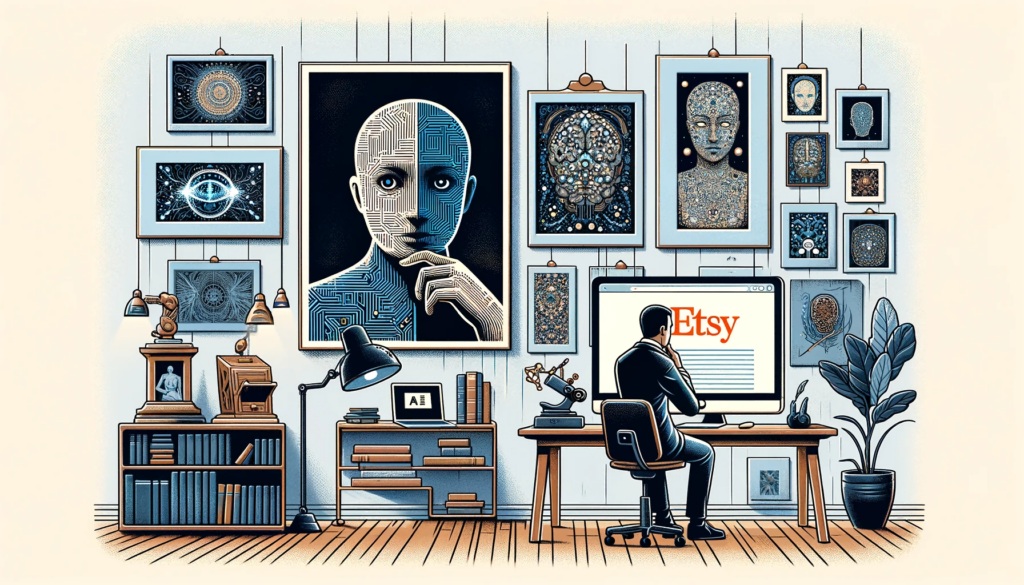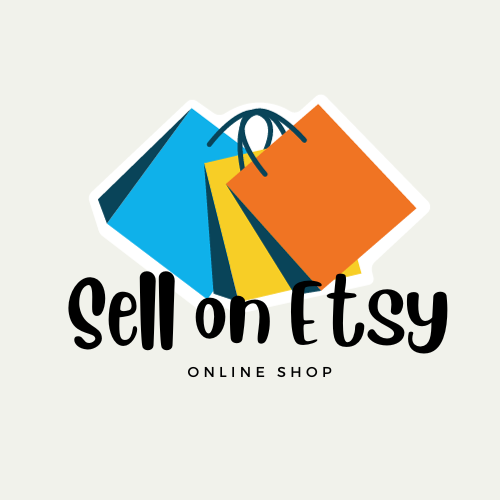Exploring the Legality of Selling AI-Generated Art on Etsy

The Rise of AI-Generated Art
AI-generated art has sparked a revolution in the art world, pushing the boundaries of creativity and raising intriguing legal questions. With advancements in artificial intelligence (AI), artists and enthusiasts are exploring new possibilities for artistic expression. One such avenue is the creation of AI-generated artwork, where algorithms and machine learning techniques generate unique pieces.
Platforms like Etsy have embraced this emerging trend, providing a marketplace for selling AI-generated art. Artists, photographers, and even hobbyists can now showcase and sell their AI-created masterpieces to a global audience. This shift has opened up exciting opportunities for both creators and buyers alike.
The allure of AI-generated art lies in its ability to produce original works that challenge traditional notions of authorship and creativity. By leveraging complex algorithms, artists can create stunning visuals that captivate viewers. From abstract compositions to realistic portraits, the possibilities seem endless.
However, as this new form of art gains popularity, it also brings forth legal considerations. The legality of selling AI-generated art on platforms like Etsy raises important questions about copyright, intellectual property rights, and the challenges faced by artists and sellers in this evolving landscape.
In this blog post, we will delve into the legality surrounding the sale of AI-generated art on Etsy. We will explore copyright laws that protect original artistic expressions, including AI-generated artwork. Additionally, we will discuss fair use exceptions that may apply to certain cases of AI-generated art.
Whether you're an artist looking to sell your AI creations or an enthusiast curious about the legal implications, this blog aims to provide insights and guidance on navigating the exciting yet complex world of selling AI-generated art on Etsy.
Understanding Copyright Laws
Copyright is a fundamental aspect of protecting original artistic expressions, including AI-generated art. As artists and sellers venture into the world of AI-generated art on platforms like Etsy, it becomes crucial to understand the intricacies of copyright laws and how they apply to this unique form of creativity.
Copyright Basics for AI-Generated Art
AI-generated art, despite being created by algorithms and machine learning processes, can still be eligible for copyright protection. The key criterion for copyright protection is that the work must be an original creation. In the case of AI-generated art, the artist or creator who developed or trained the algorithm may be considered the author and owner of the artwork.
However, AI-generated art raises questions about authorship and ownership. Unlike traditional forms of art where a human artist's skill and creativity are directly involved in every brushstroke or composition, AI-generated art relies on algorithms to produce unique visuals. This distinction challenges conventional notions of authorship and ownership in copyright law.
To navigate this complex landscape, artists and sellers of AI-generated art should familiarize themselves with copyright laws specific to their jurisdiction. Understanding the legal framework surrounding intellectual property rights will help protect their creations and ensure compliance with relevant regulations.
Fair Use and AI-Generated Art
Fair use exceptions provide some flexibility when it comes to using copyrighted material without permission from the copyright holder. These exceptions may also apply to certain cases involving AI-generated art. However, determining fair use requires careful consideration of various factors:
- Purpose: The purpose for which the AI-generated artwork is used plays a significant role in determining fair use. If it serves a transformative purpose such as commentary, criticism, or parody, it may be more likely to qualify as fair use.
- Nature: The nature of both the original copyrighted work and the AI-generated artwork is taken into account. Transformative works that significantly differ from their source material are more likely to be considered fair use.
- Amount: The amount and substantiality of the copyrighted material used in the AI-generated artwork is a crucial factor. Using only a small portion of the original work may lean towards fair use, while using a substantial portion may raise copyright infringement concerns.
- Effect: The effect of the AI-generated artwork on the market for the original copyrighted work is considered. If the new creation does not negatively impact the market value or potential sales of the original work, it may be more likely to qualify as fair use.
Artists and sellers should be aware of these fair use guidelines to avoid unintentional copyright infringement when creating and selling AI-generated art. Consulting with legal experts can provide further clarity on how fair use applies to specific cases.
Navigating Intellectual Property Rights
Intellectual property rights play a crucial role in protecting the creations and innovations of artists and sellers in the realm of AI-generated art. While copyright is the primary form of protection, it's essential to understand other aspects of intellectual property rights, such as patents and trademarks.
Patents and AI-Generated Art
Patents are typically associated with protecting inventions and processes. However, when it comes to AI-generated art, obtaining a patent may not be straightforward. The question of whether AI can be considered an inventor is a legal debate that has yet to be definitively resolved in the realm of intellectual property rights.
Currently, most patent offices require an identifiable human inventor for granting patents. Since AI algorithms generate art independently without direct human intervention for each creation, they may not meet the criteria for inventorship. As a result, obtaining patent protection solely for AI-generated art may pose challenges.
Artists and sellers interested in exploring patent protection for their AI-related inventions or processes should consult with legal experts well-versed in intellectual property laws. These professionals can provide guidance on navigating the complexities surrounding patents and help determine if any aspects of their work are eligible for patent protection.
Trademarks and AI-Generated Art
Trademark protection can apply to various aspects of AI-generated art beyond just the artwork itself. For example, if an artist or seller uses specific branding elements or logos associated with their AI-generated art, they may consider seeking trademark registration to protect those distinctive identifiers.
Registering trademarks helps establish exclusive rights over certain visual elements or brand names associated with the AI-generated artwork. This step can prevent others from using similar marks that could cause confusion among consumers or dilute the artist's brand identity.
Avoiding trademark infringement is crucial for a successful business built around AI-generated art. Conducting thorough research before finalizing branding elements or logos can help identify any potential conflicts with existing trademarks. Legal professionals specializing in intellectual property can assist in the trademark registration process and provide guidance on maintaining compliance with trademark laws.
Unraveling the Legal Landscape
Navigating the legal landscape is essential for artists and sellers of AI-generated art to ensure compliance with relevant laws and protect their creations. Two crucial aspects to consider are licensing AI-generated art and understanding international legal considerations.
Licensing AI-Generated Art
Licensing AI-generated art provides artists with a means to control how their creations are used while also offering potential opportunities to earn royalties. By licensing their AI-generated artwork, artists can specify the terms and conditions under which others can use or reproduce their work.
One popular option for licensing is Creative Commons licenses, which allow artists to grant permissions for specific uses while retaining certain rights. These licenses provide a framework that balances the artist's desire for recognition and protection with the need for broader access and collaboration.
Alternatively, artists may choose custom licensing agreements tailored to their specific requirements. These agreements can provide more flexibility in granting permissions, setting usage fees, or establishing exclusive rights over certain aspects of the AI-generated art.
Understanding licensing options is crucial for both artists and sellers of AI-generated art. It allows them to protect their intellectual property rights, maintain control over how their creations are used, and potentially generate income from their work.
International Legal Considerations
Selling AI-generated art internationally introduces additional complexities due to varying legal frameworks across different countries. Copyright laws and intellectual property rights may differ significantly from one jurisdiction to another, requiring artists and sellers to research and comply with international legal requirements.
When selling AI-generated art internationally, it's important to understand the copyright laws of each target market. This includes knowing how long copyright protection lasts in each country, what constitutes infringement under local laws, and any specific regulations related to digital or online sales.
Intellectual property rights also vary across borders, making it necessary for artists and sellers to be aware of trademark laws in different jurisdictions. Registering trademarks in relevant markets can help protect branding elements associated with AI-generated art from unauthorized use or infringement.
To ensure compliance with international legal requirements, artists and sellers should consult legal experts with expertise in intellectual property and international law. These professionals can provide guidance on navigating the complexities of selling AI-generated art across borders while safeguarding the artist's rights and interests.
Overcoming Hurdles in the AI Art Market
The AI-generated art market presents unique challenges that artists and sellers must overcome to foster growth and establish trust within the industry. Two significant hurdles in this market are proving the authenticity of AI-generated art and addressing ethical concerns surrounding its creation.
Proving Authenticity of AI-Generated Art
Proving the authenticity of AI-generated art can be challenging due to its digital nature and the involvement of algorithms. Unlike traditional art forms, where an artist's handiwork leaves physical traces, AI-generated art exists solely in a digital format. This raises questions about how to verify its origin and ensure that it is not tampered with or misrepresented.
To address this challenge, artists and sellers can leverage blockchain technology. Blockchain provides a decentralized and transparent system for recording transactions, including the creation and ownership history of AI-generated artworks. By utilizing blockchain platforms specifically designed for art authentication, such as non-fungible tokens (NFTs), artists can establish a verifiable record of their creations' authenticity.
Additionally, certificates of authenticity issued by trusted entities can also help establish credibility in the AI art market. These certificates provide detailed information about the artwork's creation process, including the role of AI algorithms. They serve as tangible proof that an artwork is an original creation generated through artificial intelligence.
Building trust and transparency within the AI art market is crucial for its continued growth. By implementing technologies like blockchain and providing certificates of authenticity, artists and sellers can instill confidence in buyers who may be hesitant to invest in AI-generated art.
Addressing Ethical Concerns
The rise of AI-generated art has sparked ethical concerns regarding authorship and creativity. Critics argue that since algorithms generate these artworks, they lack human intentionality or emotional depth traditionally associated with artistic expression. Artists and sellers must address these concerns to foster acceptance within the broader creative community.
Transparency is key when addressing ethical concerns related to AI-generated art. Artists and sellers should clearly communicate the role of AI in the creation process, ensuring that potential buyers understand the collaborative nature between human creativity and machine algorithms. By being transparent about their use of AI, artists can alleviate concerns about authenticity and foster a deeper appreciation for the unique artistic possibilities that emerge from this collaboration.
Engaging in ethical practices is also essential for the acceptance of AI-generated art. This includes respecting copyright laws, obtaining proper licenses for source materials used in training algorithms, and avoiding plagiarism or unauthorized use of others' work. By adhering to ethical guidelines, artists and sellers contribute to a more sustainable and respected AI art market.
Selling AI-Generated Photos: Best Practices
Selling AI-generated photos on platforms like Etsy requires artists and sellers to adopt best practices that enhance the marketability of their creations while ensuring transparency and compliance with copyright laws.
Creating Unique AI-Generated Photos
Creating unique AI-generated photos adds value to the artwork and reduces concerns related to copyright infringement. By experimenting with different AI algorithms and techniques, artists can produce visually captivating images that stand out from generic or widely available content. This uniqueness not only attracts potential buyers but also minimizes the risk of infringing upon existing copyrighted works.
Artists should explore various AI models, training data sets, and parameters to generate distinct styles and compositions. This experimentation allows them to develop a signature aesthetic that sets their AI-generated photos apart from others in the market. Offering exclusive limited editions or one-of-a-kind prints further enhances the marketability of these unique creations.
Disclosing AI Generation in Listings
Transparency is crucial when selling AI-generated photos. Disclosing the use of AI in listings builds trust with buyers by providing them with insights into the creation process. Clearly communicating that an artwork was generated using artificial intelligence helps potential buyers understand and appreciate the collaborative nature between human creativity and machine algorithms.
In listing descriptions, artists should explicitly state that their work is created using AI algorithms. They can describe how they trained or fine-tuned the model, what datasets were used, and any other relevant details about the process. This level of transparency assures buyers that they are purchasing authentic AI-generated art.
Honesty is key for successful sales of AI-generated photos. Artists should avoid misrepresenting their work as entirely human-created or misleading buyers about the extent of human involvement in its production. By being transparent about the role of AI in generating the photos, artists can establish trust with buyers who may have reservations about purchasing AI-created art.
The Future of AI-Generated Art on Etsy
The future of AI-generated art on platforms like Etsy is promising, but it also comes with evolving legal considerations. As the field continues to advance, artists, photographers, and Etsy sellers must stay informed about the changing legal landscape to ensure compliance and protect their creations.
By adhering to best practices and understanding the legal implications surrounding AI-generated art, artists can thrive in this emerging market. They should continue to explore unique techniques and experiment with different AI algorithms to create captivating and original artworks that resonate with buyers.
Etsy sellers specializing in AI-generated art should remain vigilant about legal developments related to copyright laws, intellectual property rights, licensing options, and international regulations. Staying up-to-date on these matters will help them navigate potential challenges and seize opportunities within the AI-generated art marketplace.
As the acceptance of AI-generated art grows, it is essential for artists and sellers to build trust with buyers. Proving authenticity through blockchain technology or certificates of authenticity can enhance credibility and provide assurance to potential customers.
Furthermore, addressing ethical concerns by being transparent about the use of AI in the creation process fosters acceptance within the broader creative community. Engaging in ethical practices ensures that AI-generated art is embraced as a legitimate form of artistic expression.
With a solid understanding of legal considerations and a commitment to best practices, the future looks bright for selling AI-generated photos on Etsy. Artists have an opportunity to shape this evolving landscape by embracing technological advancements while upholding integrity and creativity in their work.





